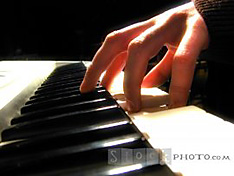Pianists' Four Kinds of Memory by Francis Dubé
/ November 5, 2003
Version française...
 It is considered traditional for pianists to memorize
their solo repertoire. However, this was not always the case; for a long time
reading from the score overshadowed memorization. It was Franz Liszt, the 19th
century composer and virtuoso pianist, who was the first performer to present an
entire recital by memory. One hundred and fifty years later his initiative
endures. It is considered traditional for pianists to memorize
their solo repertoire. However, this was not always the case; for a long time
reading from the score overshadowed memorization. It was Franz Liszt, the 19th
century composer and virtuoso pianist, who was the first performer to present an
entire recital by memory. One hundred and fifty years later his initiative
endures.
Few pianists dare question this
legacy these days, and yet the memorization of a musical score remains a
difficult exercise for most. It is a complex and daunting task. To be
successful, a performer must call on several senses (hearing, sight, touch) and
mentally manipulate a lot of data to avoid a memory lapse during a public
performance.
Though pianists have been
memorizing for a long time, not much is known about the process. However, recent
scientific research has provided us with some of its basic elements.
The act of memorization calls
on several distinct types of memory, of which a pianist uses four to memorize a
work in his/her repertoire: auditory, visual, kinesthetic and conceptual. Each
fulfills a specific role in the process, but it is their mutual interaction that
allows a pianist to remember. All kinds of memory must work together to be truly
efficient.
Auditory memory
Auditory memory is what is
activated when people belt out their favourite tune in the shower. Since music
is essentially an assortment of sounds, auditory memory plays a dominant role in
a pianist's memorization. A performer uses it to accomplish two specific tasks:
to know if he/she is playing the right notes, and to anticipate what he/she will
play in the next few seconds. Without this, the pianist would inadvertently play
the wrong notes and the sequence of movements would be laborious and
insecure.
Visual memory
Visual memory allows humans to
record large amounts of information, from faces and colours to everyday objects.
This cognitive ability is used abundantly by a pianist in the memorization of a
score. First, it enables a pianist to internally visualize the score during a
performance. Second, it is used to recall the physical gestures involved in
playing, much in the same way a dancer recalls his/her movements.
Kinesthetic memory
Kinesthetic sense allows people
to feel internally the movements of their muscles, joints and tendons. Thus, all
physical activity, such activities as walking or bicycling, draws on kinesthetic
memory to automate movement. As playing the piano requires many automatic
physical actions, kinesthetic memory is essential for the memorization of a
score, i.e., all the movements, gestures and physical sensations needed to play
a musical work.
Conceptual memory
Some kinds of memory are
recorded in the brain by repetition without special effort on the part of the
individual. Auditory, visual, and kinesthetic memories, although they can be
reinforced by various exercises, fall into this category. Although they are
essential to the pianist in his/her mnemonic work, none of these types of memory
provide for retention of the musical text. Only conceptual memory, used
intentionally, allows a pianist to integrate this knowledge. To be more precise,
a pianist must be totally aware of what is being memorized to really absorb and
retain the score. Conceptual memory provides total assimilation of the musical
text, including harmony, nuances, phrasing, reference points, and notes. In
short, conceptual memory is acquired by exceptional effort while the three
preceding types are recorded automatically while practicing. Finally, this
memory provides for the synthesis of information into a single brain concept.
For example, instead of separately memorizing the major notes (seven different
elements), the pianist has to retain only the basic scale of C major (a single
concept).
Looking to the future...
In the past few years science
has made great progress in understanding human memory, notably by such
state-of-the-art technologies as magnetic resonance imaging (MRI). However, many
questions remain unanswered, and this inevitably affects our understanding of
the pianist's memorization process. The problem stems from the predominance of
scientific studies that focus mainly on short-term rather than long-term musical
memory, as memorizing a score depends on the latter system. A major consequence
of this situation is that pianists must continue to build and develop their own
system, for better or for worse.
Microanalysis, an element of
conceptual memory, can be defined as a learning activity in which a pianist
verbalizes in his/her own words various observations or reference points
necessary for him/her to play by memory. These might be, for example, the
identification of common notes in consecutive chords, or the parallel or
contrary motion in a specific passage. Despite our awareness that microanalysis
is a common practice in the work of a pianist's memorization, this segment of
conceptual memory has never been the subject of a systematic study. My research
aims to inventory the different types of microanalysis used by pianists of
varying levels (pre-university, university, and professional).
To sum up, as our understanding
of long-term musical memory improves, the process of the memorization of a piano
score will become clearer. As more scientists dedicate research to this
cognitive problem, more piano teachers will be effective in establishing,
through the years, a true pedagogy in the art of memorization.
[Translated by Susan Spier]
The
author has been a piano instructor in the Faculty of Music at Laval University
since 1998. His students have won prestigious awards such as the prix d'Europe
1998, first prize in the MSO competition in 2000, and first prize in the
competition of the Fédération des professeurs de musique du Canada in 2001 and
2003. He is currently pursuing a doctorate in music education at Laval
University under Marie-Michèle Boulet.
Version française... |
|


